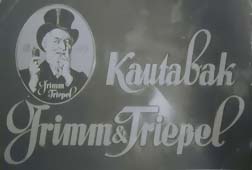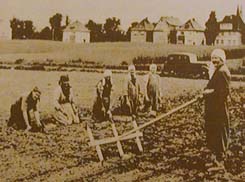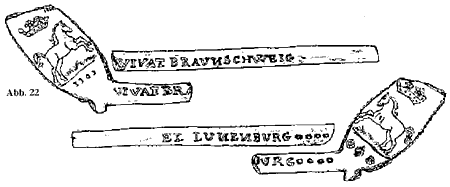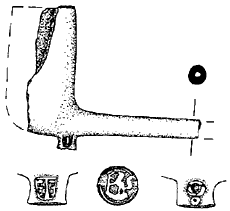No. 11/1998 p. 1-4
Martin Kügler: Report on the 11th meeting of the German
Society for Clay-Pipe Research held in Nordhausen on 3 and 4 May
1997
The society was invited to Nordhausen by the Nordhausen Historical
and Antiquity Society; 39 people attended. H.-J. Grönke and
P. Lauerwald both gave lectures on the history of tobacco in Nordhausen
(Knasterkopf No. 11/1998, p. 4-13 and 13-24). E. Reiff presented
the results of clay-pipe research in the eastern Harz Mts. U. Beck
and G. Heinssen-Levens reported on clay pipes with "VIVAT ..."
on the stem that had been found in the old part of Hamburg (Knasterkopf
No. 11/1998, p. 25-45), and N. Frentrop described clay-pipe fragments
found in Soest. W. Morgenroth gave an account of the standard of
living of pipe makers in Ruhla, and M. Kügler dealt with the
competition that developed between pipes made of different materials.
The excursion visited the Nordhausen cigarette factory, the Tobacco
Warehouse Museum and the Nordhausen Special Distillery.

No. 11/1998, p. 4-13
Hans-Jürgen Grönke: A view of the chewing-tobacco industry
in Nordhausen
As early as 1721, the tobacco spinners of Nordhausen, a free town
of the Reich, applied to the town councillors for permission to
establish a guild. A list of Nordhausen citizens dated 1724 mentions
two tobacco merchants and one (clay ?) pipemaker. The tobacco industry
in the town appears to have remained at quite a low in level throughout
the 18th century. However, in the 1820s tobacco processing began
to grow and Nordhausen eventually became the main centre of chewing-tobacco
production in Germany. Since chewing-tobacco manufacture required
little capital investment, many of the tobacco spinners and other
workers set up their own businesses, which, on account of the considerable
demand, rapidly grew into sizeable factories. As a result we see
that in 1880 there were 13 tobacco factories (many of them producing
chewing-tobacco) in Nordhausen employing a total of 1000 workers,
and in 1925 there were 25 factories which employed 2000 workers
and accounted for 59% of Germany´s total production of chewing-tobacco.
The 2nd World War saw the end of Nordhausen´s dominant position
in the tobacco processing industry, of which only a few of the former
factory buildings remain.

Trade sign advertising Grimm & Triepel's snuff,
about 1900/1910

No. 11/1998, p. 13-24
Paul Lauerwald: Tobacco growing in the Eichsfeld area
| In Thuringia, on account
of the climate, tobacco could be grown satisfactorily only in
the Untereichsfeld area, which was known as the "Goldene
Mark". Production of tobacco for cigars, cigarettes and
chewing took place in the Obereichsfeld area. In Duderstadt,
the first record of tobacco growing was in 1660, and in 1673
the town council passed and issued the first regulations for
tobacco trading and nominated an inspector of tobacco. In 1682,
tobacco growing and the tobacco trade were discontinued because
of the plague, but recovered slowly and only attained their
former importance about a century later. In the 19th century,
tobacco was mostly grown by smallholders, who organized themselves
into a trading association in order to achieve minimum price
limits when the tobacco harvest was auctioned. Trade began to
contract in the 1920s, and in 1960 a tobacco virus spelt the
ultimate end of tobacco growing. |
|

Planting tobacco seedlings
in lower Eichsfeld around 1930
|

No. 11/1998, p. 24-45
Ursel Beck/Gudrun Heinssen-Levens: VIVAT HAMBURG. Clay-pipe finds
from Hamburg "Neustadt"
So far, a total of 1050 clay-pipe bowls and about 3000 pipe-stem
fragments have been recovered from a gravel pit where soil from
building sites in the old part of Hamburg was dumped. These finds
date from the 17th and early 18th centuries. This paper deals with
clay pipes bearing the inscription "VIVAT" on the stem.
This exclamation normally precedes the name of a territory, a city
or a person. The corresponding pipe bowl commonly bears a view or
the coat-of-arms of the territory mentioned on the stem. Some pipes
bear the inscription "VIVAT BRAUNSCHWEIG ET LUNEBURG"
on the stem and a prancing horse, the main feature of the coat-of-arms
of the Duchy of Braunschweig-Lüneburg, and the date 1703 on
the bowl. Other examples also date around 1700. So far, no record
has been found of clay-pipe makers based in Hamburg at this time,
suggesting that these finds are imports, although their origin is
still unknown.

"Vivat" pipe with inscription on stem
and a prancing horse on the bowl, dated 1703, provenance not known

|
|
|

|
No. 11/1998, p. 46-49
Rüdiger Articus: Zapfenberg pipes
Clay-pipes bearing the name "Zapfenberg" are relatively
frequently found but it has so far not been clear whether this name
refers to a clay-pipe maker or to a town. Records have now been uncovered
in literature dating from 1712 onwards to demonstrate that the name
refers to an important tobacco merchant. "Zapfenberg tobacco"
was a well known trade name throughout the 18th century. However,
it is still not known where Zapfenberg lived. The pipes bearing his
name were probably produced for him on commission, but the place of
manufacture also remains unknown.

Pipe with the heel mark "6"
and stem inscription "SAPFEN / BERCK",
probably German, 18th century
|
|
No. 11/1998, p. 49-55
Ralf Kluttig-Altmann: Clay-pipe finds from the centre of Leipzig
|
A number of clay-pipe fragments were found in 1996 during
excavation of a filled-in communal well on a plot of land
at Hainstrasse 12 in the centre of Leipzig. Amongst the finds
were eight stem fragments bearing ornamentation and six bowl
fragments bearing marks. They date from between the late 17th
and 20th centuries, predominantly from the 18th century. These
pipe fragments comprise products made by the Verzijl family,
Gouda, and fake Gouda pipes probably made in Saxony. The latter
can be identified from the use of the Gouda coat-of-arms and
the name of pipemaker Laspe from Saxony on the same clay pipe.
Pipe with heel showing heel mark "Lion
in a Dutch garden",
and marks on both sides of the heel,
one of them a mould-identification mark,
probably made in Saxony, after 1800
|
|
 |

|
|
|
|
No. 11/1998, p. 56-74
Christiane Witte: Clay-pipe finds in Tönning
The records of the port authority in Tönning show that tobacco
was imported here as early as 1627. Imports of Dutch clay pipes, the
bulk of which were marketed inland, are first documented in the 1680s
and this trade continued in the 18th century. Clay-pipe finds discovered
in 1989 in Tönning include many imports from Gouda. Some fragments
bearing well known marks occur, such as the "lamb under the tree",
"King David with sword and head" and "the serpent".
Inscriptions on some of the pipe stems suggest that, in the late 18th
and early 19th centuries, German clay pipes from Itzehoe, Uslar and
Wahmbeck were also smoked in Tönning.

Fragment of stem from a clay pipe made in Uslar around 1800
|
|
No. 11/1998, p. 74 ff.
Rüdiger Articus: A visit to Gouda 288 years ago
During his travels through Germany and the neighbouring countries,
the Frankfurt partrician Zacharias Conrad von Uffenbach went to
Gouda in 1710 and visited a clay-pipe factory. In the account of
his travels, which was published posthumously, he described how
clay pipes were made; in contrast with later descriptions, his account
of the process is accurate.

No. 11/1998, p. 76-79
Martin Kügler: Report on the first Swiss Clay-Pipe Conference,
held in Liesetal on 26 March 1998
The meeting took place in the Basel Canton Museum in Liesetal at
the initiative of Michael Schmaedecke, who read a paper on the use
of clay pipes in the region that is now Switzerland. R. Röber
compared clay pipes found in Constance with those found in Freiburg.
I. Jensen described selected examples of the clay pipes produced
in the Electorate of the Palatinate during the 17th century. M.
Kügler gave an account based on documentary evidence of the
trade in clay pipes imported into Switzerland from the Westerwald
in the late 18th and 19th centuries. Finally, clay pipes found in
Constance, Freiburg, Breisach, Winterthur, Rötteln castle near
Lörrach, from the Cantons of Zug and Basel Land and from the
Westerwald were shown to the meeting.
|
|

